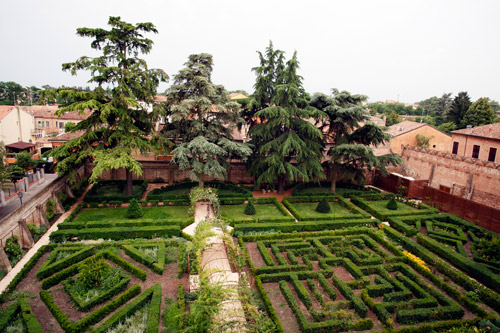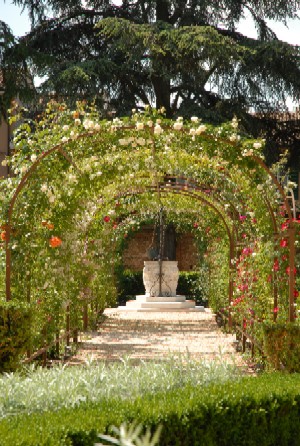The large Renaissance garden is an impressive example of a historical formal garden. Actually, it is not the original one, but rather a realization “in style” done in the thirties, and reduced in extension compared to the original. This representative garden was once placed in the east, along the ancient Via Ghiara.

Its current look is the result of the restoration completed in 2010, which considered not only the centuries-old history of the area, but also the needs for maintenance and those of the visitors, creating both usability and harmony conditions.
Until the early twentieth century the garden was a simple cultivated vegetable garden. In the thirties, during the restoration for the opening of the Archaeological Museum, its look was modified, as a result of an imaginary reconstruction of a Renaissance garden. The garden was divided in squares, flowerbeds were outlined keeping the lines of existing routes. According to ornamental horticulture tradition of the twentieth century, the southern area was finished with curved exedras of privet, a plant that wouldn’t be found in a sixteenth century garden. After the fifties other items were added: a labyrinth,a rose gallery, inner garden schemes, and other tree species, thus losing the formal unity.

The restoration project of 2009-2010, developed by the Ministry of Heritage and Culture, in collaboration with specialists in the field, has given a complete picture of the gardens history and development. The result was made possible thanks to research, investigation and preliminary analysis of the intervention: landscape archaeology (archaeobotanical and palynological investigations, agronomic studies)reconstructed a vast open space, with few trees, medium-size garden spaces with fruit trees, interspersed with large lawn and uncultivated areas. The species are those typical for wetlands, with a significant concentration of grains, especially barley and wheat. The archaeological investigations have brought to light levels that are prior and contemporaneous to the arrangement of the area for the construction of the palace. There are also remains of a wall, already demolished in the eighteen century, that cuts across the garden and had a door with access to the external cultivated vegetable and fruit garden.